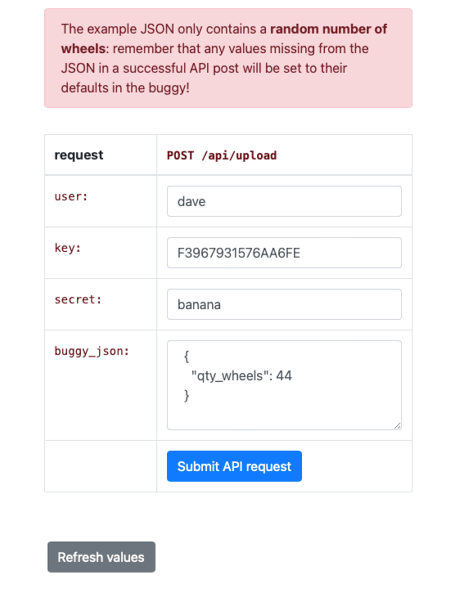The race server API
The server supports a mechanism for uploading buggy JSON programmatically. It’s “the race server API” and students encounter it in task 4-API.
The API does not use the same login/session mechanism as the website. Instead it requires a valid combination of username, key, and secret.
See the full public API specification.
See task 4-API, which invites your students to use the API.
If you edit the tasks so that the API task isn’t in phase 4 any more, you should change the config setting TASK_NAME_FOR_API in the “Tasks” group.
| Key | Value |
|---|---|
username | Username of a valid, active user |
key | String for this user (set by staff, lasts until staff changes it) |
secret | String for this user (set by user, times out, and potentially only used once) |
These config settings in the “Server” group control how the API criteria behave:
| Config setting | Effect |
|---|---|
API_SECRET_TIME_TO_LIVE | Lifespan of API secret from the moment it is set. |
IS_API_SECRET_ONE_TIME_PW | Can the secret be used repeatedly (within its lifespan), or is it one-time-use only? |
IS_STUDENT_API_OTP_ALLOWED | If the secret is not a one-time password, can a student override their own so that it is? |
The API is an introduction to the usefulness of APIs: it’s replacing a manual process that the students have been using (copying and pasting the buggy JSON into the upload form) with a programmatic one. The mechanism of using a key and a secret (and potentially that secret being a one-time token) is an example of how transactions like payments work on the web.
Setting API keys
As a staff member, you can set the API key for any individual user. Select the user or users to which you want to allocate a key, and click Generate API keys. The server will randomise a separate key for each user you selected.
Similarly, you can revoke a key by clicking Clear API keys.
We suggest that you do not grant API keys until individual students ask for one. It’s a simple way to check with their progress and an opportunity to see how much they’ve understood about how the API works.
Setting the API secret
Users set their own API secret.
API test page
If you’re logged in as a member of staff, you can play with the API to see how it works and what its (JSON) responses look like. The test generates a JSON buggy description that contains only one value — qty_wheels — set to a random integer. You’ll need to set both a key and a secret if you want the API POST call to succeed. This is a genuine API call so if the criteria are correct, it will change your buggy.

The API test generates an HTTP POST request to the /api endpoint with the parameters from the form.